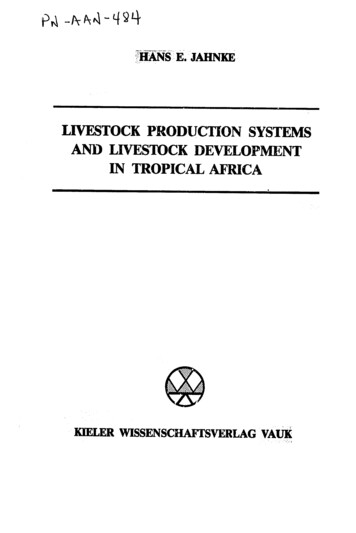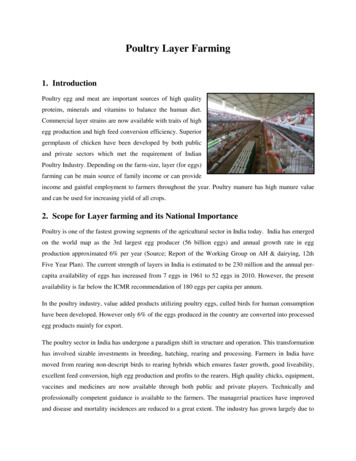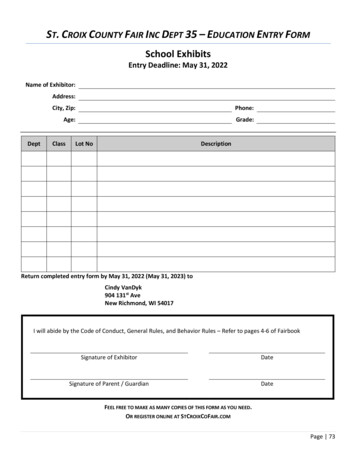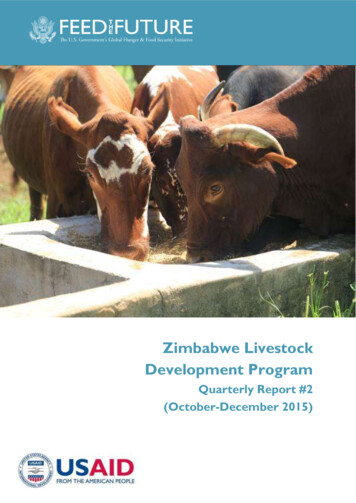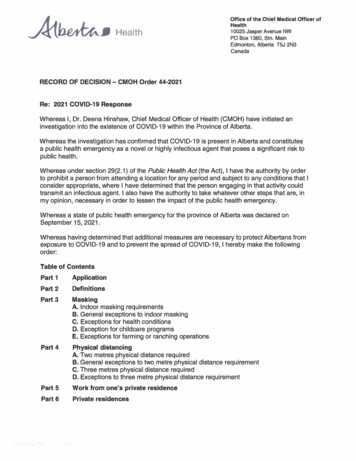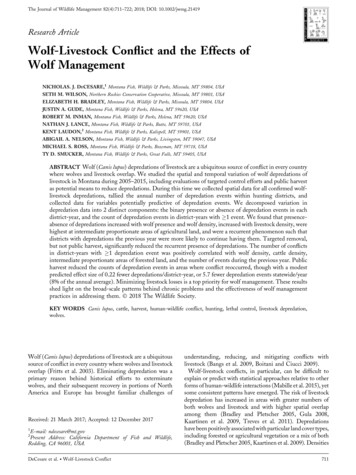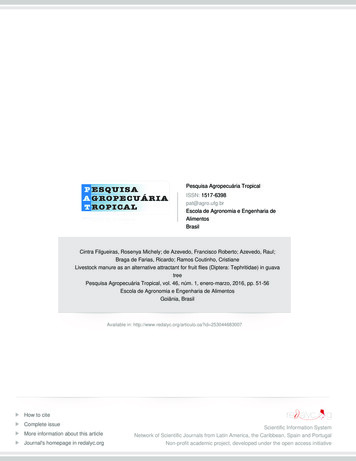
Transcription
Pesquisa Agropecuária TropicalISSN: 1517-6398pat@agro.ufg.brEscola de Agronomia e Engenharia deAlimentosBrasilCintra Filgueiras, Rosenya Michely; de Azevedo, Francisco Roberto; Azevedo, Raul;Braga de Farias, Ricardo; Ramos Coutinho, CristianeLivestock manure as an alternative attractant for fruit flies (Diptera: Tephritidae) in guavatreePesquisa Agropecuária Tropical, vol. 46, núm. 1, enero-marzo, 2016, pp. 51-56Escola de Agronomia e Engenharia de AlimentosGoiânia, BrasilAvailable in: http://www.redalyc.org/articulo.oa?id 253044683007How to citeComplete issueMore information about this articleJournal's homepage in redalyc.orgScientific Information SystemNetwork of Scientific Journals from Latin America, the Caribbean, Spain and PortugalNon-profit academic project, developed under the open access initiative
e-ISSN 1983-4063 - www.agro.ufg.br/pat - Pesq. Agropec. Trop., Goiânia, v. 46, n. 1, p. 51-56, Jan./Mar. 2016Livestock manure as an alternative attractantfor fruit flies (Diptera: Tephritidae) in guava tree1Rosenya Michely Cintra Filgueiras2, Francisco Roberto de Azevedo3,Raul Azevedo3, Ricardo Braga de Farias3, Cristiane Ramos Coutinho2ABSTRACTFruit flies are typically managed using hydrolyzedprotein, which is difficult for family farmers to obtain. Thisstudy aimed at assessing the efficiency of livestock manurefor monitoring and/or controlling this pest in guava treeorchards. The first experiment tested the efficiency of guavajuice and manure from cattle, sheep, pig, horse and chickenas attractants for fruit flies. Once the best bait had beenestablished, a second experiment was conducted using guavajuice and chicken manure extract at concentrations of 10 %,30 %, 50 %, 70 % and 100 %. A third assay analyzed guavajuice and chicken manure extract (10 %) at three attractantaging periods (3, 7 and 14 days after trap installation). Thecost-effectiveness ratio between guava juice and extractwas also analyzed. It was concluded that fruit flies preferthe chicken manure extract (10 %), with greater captureobserved three days after trap installation, which can replacethe guava juice in the agroecological management of fruitflies in guava trees in family farms, since it is low cost andefficient.RESUMOEsterco de animais domésticos como atrativo alternativopara moscas-das-frutas (Diptera: Tephritidae) em goiabeiraAs moscas-das-frutas são manejadas com proteínahidrolisada, mas, para agricultores familiares, esse produto é dedifícil acesso. Objetivou-se avaliar a eficiência de estercos de animaisdomésticos no controle e/ou monitoramento dessa praga em pomaresde goiaba. No primeiro ensaio, avaliou-se a eficiência do suco degoiaba e de estercos bovino, ovino, suíno, equino e de galinha,como atrativos para a mosca-das-frutas. Após definição do melhoratrativo, instalou-se o segundo ensaio, utilizando-se suco de goiabae extrato de esterco de galinha nas concentrações de 10 %, 30 %,50 %, 70 % e 100 %. No terceiro ensaio, avaliou-se suco de goiabae esterco de galinha a 10 %, em três períodos de envelhecimento doatrativo (3, 7 e 14 dias após a instalação das armadilhas). A relaçãocusto/benefício do suco de goiaba e do extrato também foi avaliada.Verificou-se que as moscas-das-frutas têm preferência pelo extratode esterco de galinha a 10 %, com maior captura observada aostrês dias após a instalação, o qual pode substituir o suco de goiabano manejo agroecológico de moscas-das-frutas em goiabeiras, naagricultura familiar, pois é de baixo custo e eficaz.KEY-WORDS: Psidium guajava L.; fruit flies; natural pestcontrol.PALAVRAS-CHAVE: Psidium guajava L.; moscas frugívoras;controle natural de pragas.INTRODUCTIONfarming, not only due to the direct damage theycause in the field, especially in certain regions, butalso because of the quarantine barriers imposed bycountries that import fresh fruits (Lima et al. 2012).Fruit fly populations are managed usingtoxic baits and insecticide sprays, primarilyorganophosphates and pyrethroids, to controleggs/larvae inside fruits and adult flies outsidethem (Carvalho 2004). Although this technique isconsidered efficient for controlling insect pests,insecticides, particularly organophosphates, arehighly toxic, negatively affecting both natural enemiesBrazil is the third largest fruit producer in theworld, with an annual average of 40 million metrictons (Anuário 2010). According to Veloso et al.(2012), farmers who obtain high quality fruits, freeof pests, diseases and physiological disorders, canfind new markets.Guava (Psidium guajava L.) is one of thefruits most affected by fruit flies in Brazil. Ceratitiscapitata Wiedemann and Anastrepha spp. (Diptera:Tephritidae) are a significant problem for fruit1. Manuscript received in Sep./2015 and accepted for publication in Feb./2016 2. Universidade Federal do Ceará, Departamento de Fitossanidade, Fortaleza, CE, Brazil.E-mails: rosenya michelycf@hotmail.com, cris.ramos@yahoo.com.br.3. Universidade Federal do Ceará, Laboratório de Entomologia Agrícola, Crato, CE, Brazil.E-mails: roberto.azevedo@ufca.edu.br, raulbiologo@gmail.com, ribrafa@live.com.
52R. M. C. Filgueiras et al. (2016)and pollinator populations. These insecticides canremain in the environment for long periods of time,causing health and ecological concerns (Nondillo etal. 2007).Integrated pest management programs infruit farming have encouraged the use of differentmethods to control fruit flies. Among them is theuse of attractants, aiming at reducing pest populationdensity (Alves 2010).Given the quarantine-based significance of fruitflies in commercial orchards, the trapping devices andbaits used must be effective and capable of detectingthe presence of these tephritids. As such, effectivemonitoring depends on the quality of the attractant(food or sexual) and its distribution in strategic pointsthroughout the orchard. Effective capture of adults isimportant for monitoring populations and planningproper orchard management (Carvalho 2005).Monitoring fruit flies is vital and generallyachieved using a McPhail trap baited with hydrolyzedprotein (Monteiro et al. 2007). However, for familyfarmers, this technology is difficult to obtain, due toits high cost and low availability. As such, alternativeand less expensive attractants are being sought formonitoring systems, including fruit juices, urea,molasses, urine and chicken manure. Ammonia is alsoused to monitor fruit fly populations. Kendra et al.(2005) found that ammonia was efficient in capturingfruit flies, being especially attractive to females.The present study aimed at assessing theefficiency of livestock manure, in comparison withguava juice, as an alternative for controlling and/ormonitoring fruit flies (Anastrepha spp. and Ceratitiscapitata).MATERIAL AND METHODSStudies were conducted in a family farm witha ten years old Paluma guava (Psidium guajava L.)orchard, in Barbalha (7º17’18”S, 39º20’57”W andaltitude of 459.2 m), Ceará State, Brazil, from august8th to October 31st, 2013.Guava trees were planted using 6 m x 5 mspacing, totaling an effective area of 0.5 ha. Standardcultivation practices were adopted, includingfertilization, weeding and irrigation. However,chemical insecticides were not applied to control pests.Surrounding the experimental area were the followingorchards: papaya (Carica papaya L.), passion fruit(Passiflora edulis Sims f. flavicarpa), individual redmombin trees (Spondias purpurea L.), ambarella(Spondias dulcis L.) and mangoes (Mangiferaindica L.). The study was conducted during thefruiting and ripening stages.The first experiment was performed fromAugust 8th to 15th, using a plastic McPhail trap witha yellow base as the experimental unit, distributed ina randomized blocks design, with six treatments andfive replications, totaling 30 experimental units. Thetraps were installed in the shade, in alternate rows,approximately 10 m apart and at an average height of2.0 m, in trees bearing ripe fruits ready for harvest.The treatments used were manure fromcattle, sheep, pig, horse and laying hen. The controltreatment contained 25 % of natural guava juice 10 % of granulated sugar. Each type of manure wascollected in a 20 L plastic bucket one day prior to itsuse and diluted in distilled water at a ratio of 3:1, toobtain a smooth liquid extract. Next, the liquid washomogenized, stored in 2 L transparent PET bottlesand taken to the field. Approximately 400 mL of theseextracts were placed into each trap.The baited traps remained in the field for sevendays. Insects were then collected and counted usinga fine-mesh plastic sieve and a fine brush. Capturedinsects were placed in 100 mL plastic containersfilled with 70 % of ethanol and labeled based on therespective treatments. Next, the material was takento the Agricultural Entomology Laboratory of theUniversidade Federal do Ceará, in Crato (Ceará State,Brazil), for screening and counting. The traps wereremoved from the orchard once the material had beencollected. The aim of this first phase was to assesswhich manure achieved the best result in terms ofattracting Anastrepha spp. and C. capitata adults.The second experiment was carried out fromSeptember 4th to 11th, using a plastic McPhail trapwith a yellow base as the experimental unit. Trapswere distributed in a randomized blocks design,with six treatments and five replications, totaling 30experimental units. The same methodology appliedto the previous phase was used for treatments and flycollection. Treatments were 25 % of natural guavajuice 10 % of granulated sugar as control and layinghen manure at concentrations of 10 %, 30 %, 50 %,70 % and 100 %.The third experiment (September 16th toOctober 31st) evaluated two treatments (guava juiceand 10 % chicken manure), under three aging periodsfor bait (3, 7 and 14 days), with 10 replications.e-ISSN 1983-4063 - www.agro.ufg.br/pat - Pesq. Agropec. Trop., Goiânia, v. 46, n. 1, p. 51-56, Jan./Mar. 2016
Livestock manure as an alternative attractant for fruit flies (Diptera: Tephritidae) in guava treeTwenty experimental units were evaluated in eachassessment, using the same treatment application andcollection methods as the previous phase.The number of adult fruit flies captured overseven days in McPhail traps baited with natural guavajuice and livestock manure diluted (3:1) in distilledwater and also the average number of fruit fliescaptured every seven days in McPhail traps baitedwith different concentrations of laying hen manurewere submitted to statistical normality, using aShapiro-Wilk’s test. Non-normal data were convertedinto (x 0.5) and submitted to analysis of variance,and means were compared by the Tukey’s test, at5 %. All tests were carried out using the PAST 3.0software. Data on the average number of collectedfruit flies sampled by McPhail traps baited with threeaging periods with 10 % of chicken manure extractand 25 % of guava juice plus 10 % of sugar weresubmitted to regression analysis, using the Excelsoftware (Microsoft, Washington, USA).Cost-effectiveness of the best treatments,expressed in monetary terms, was evaluated. Theprice of guava pulp and its application in the controlof fruit flies was analyzed and contrasted with 10 %of laying hen manure extracted from an orchardowned by a family farmer in Cariri (Ceará State,Brazil).RESULTS AND DISCUSSIONThe laying hen manure extract resulted inthe highest number of captured flies, significantlydiffering from the other extracts used. However, thenumber of captured flies was significantly differentand twice as high for the guava juice control, whencompared to chicken manure (Table 1).Prokopy et al. (1992) compared chickenmanure to commercial attractants in laboratoryand found that the manure attracted significantlymore C. capitata. However, similarly to our results,chicken manure was significantly less attractive thanguava juice.Epsky et al. (1997) compared a crude chickenmanure extract with a methanolic chicken manureextract in laboratory and observed that chickendroppings captured more A. suspensa Loew (Diptera:Tephritidae) than the methanol extract. The authorsattributed this difference to a possible decline in themicrobial activity of methanol, thereby reducing therelease of ammonia by the extract.53Poultry manure attracts fruit flies becauseof the release of volatile compounds, includingammonia, by bacteria fermentation (Robacker etal. 2000). Protein baits, agricultural supplementssuch as synthetic fertilizers, animal waste andany decomposing material produce and releaseammonia during putrefication. The course and speedof decomposition is the result of the interactionbetween biotic (microbial activity) and abiotic factors(temperature, precipitation and wind) (Sommer &Hutchings 2001).Rull & Prokopy (2000) tested chicken manureand odoriferous ethyl hexanoate bait for capturingRhagoletis pomonella Walsh (Diptera: Tephritidae).They found that chicken manure did not affect thecapture of males, but considerably increased thecapture rate of juvenile females. These results suggestthat chicken manure can be used as an alternativemethod to control fruit flies, increasing the capturerate of females.Piñero et al. (2003) compared the efficiencyof chicken manure, human urine and hydrolyzedprotein in the capture of fruit flies in a mango(Mangifera indica L.) crop. They observed moreAnastrepha obliqua Macquart, A. serpentinaWiedemann, A. alveata Stone, A. chiclayae Greene,A. ludens Loew and A. zuelaniae Stone (Diptera:Tephritidae) individuals in the traps containingmanure. However, this treatment was less effectivein attracting A. obliqua and A. serpentina. One of thehypotheses raised by the authors is that the differencein pH among manure, protein and urine explains thevariation in capture numbers. Robacker et al. (2000)compared different types of duck manure and foundTable 1. Average number of adult fruit flies SE (Anastrephaspp. Ceratitis capitata) captured over seven days inMcPhail traps baited with 25 % of guava juice 10 %of granulated sugar and livestock manure diluted (3:1)in distilled water.TreatmentGuava juiceChicken manureHorse manureCattle manurePig manureSheep manureCV (%)1Average number of flies17.5 14.2 a3.6 2.1 b2.3 3.8 c1.6 2.2 c1.6 0.2 c1.1 0.1c42.19Means followed by the same letter do not differ significantly according to theTukey’s test at 5 %. Data were transformed with (x 0.5).e-ISSN 1983-4063 - www.agro.ufg.br/pat - Pesq. Agropec. Trop., Goiânia, v. 46, n. 1, p. 51-56, Jan./Mar. 2016
54R. M. C. Filgueiras et al. (2016)that more alkaline pH tended to attract more A. ludensindividuals.By testing five different concentratios ofhen manure, we observed that the dilution at10 % captured more adult flies, with no significantdifference from the control (Figure 1). Sincechicken manure is quite viscous, only the 10 %concentration formed a liquid mixture (extract)capable of attracting flies. Capture rates declinedas the concentration increased, due to the fast waterevaporation and amount of manure in the traps.Aluja & Piñero (2004) tested liquid baits containingdifferent concentrations of ammonia and found thathigh levels tended to be less attractive. The releaseof ammonina is generally regulated by pH.In behaviorial assays with A. suspense underlaboratory conditions, Kendra et al. (2005) observedthat ammonia is released primarily during thedecomposition of certain food proteins, naturallyattracting flies. The authors also found that ammoniabecame less appealing at higher concentrations,potentially repelling flies.Aluja & Piñero (2004) compared differentconcentrations of human urine and hydrolyzedcorn (Zea mays L.) protein in guava trees andfound no difference in the number of individualscaptured for A. fraterculus Wiedemann (Diptera:Tephritidae), A. ludens and A. striata Schiner(Diptera: Tephritidae). The authors suggestedthat these species responded well to the nitrogenstimulus present in the urine, as occurs with layinghen manure. In this study, higher concentrationsof manure extracts dried more easily due to thehigh temperatures in the semi-arid Cariri region,hampering the release of ammonia, which in turnreduced the attraction of adult fruit flies.Guava juice attracted significantly more adultflies than chicken manure at the third and seventhdays after bait installation. For both guava juice andchicken manure, bait effectiveness declined linearly.Two weeks after installation, both baits (guava juiceand chicken manure) were ineffective and thereforenot significantly different (Figure 2).Contrasting the results exhibited in Figures 1and 2, the decreasing trend of guava juice and chickenmanure attractiveness with time could be explainedby changes in physical and chemical composition,associated with water loss and ammonia volatilization(Sommer & Hutchings 2001, Aluja & Piñero 2004).This decline occurred because the attractants driedout after being exposed to temperatures reachingan average of 30 ºC. Water loss concentrates theammonia, and high concentrations of ammonia repelsflies (Kendra et al. 2005).Nascimento et al. (2000) recommended thattraps should be inspected up to seven days afterinstallment. After this point, the attractant solutionbecomes less effective at attracting flies, thereforecapturing fewer insects. This occurred in the presentstudy, because capture rates fell as the exposedattractants (juice and manure) aged (Figure 2).According to Azevedo et al. (2012), guavajuice is easy to obtain, inexpensive and can be usedas a replacement for hydrolyzed corn protein tocapture fruit flies. This hydrolyzed protein is used bymost farmers to monitor and/or control these pest inFigure 1. Average number of fruit flies SE (Anastrepha spp. Ceratitis capitata) captured over seven days in McPhailtraps baited with guava juice or laying hen manureextract at different concentrations. Means followed bythe same letter do not differ significantly according tothe Tukey’s test at 5 %.Figure 2. Linear regression of the average number of adult fruitflies (Anastrepha spp. Ceratitis capitata) capturedover seven days in McPhail traps baited with 10 % oflaying hen manure and 25 % of guava juice 10 %of granulated sugar submitted to three aging periods.e-ISSN 1983-4063 - www.agro.ufg.br/pat - Pesq. Agropec. Trop., Goiânia, v. 46, n. 1, p. 51-56, Jan./Mar. 2016
Livestock manure as an alternative attractant for fruit flies (Diptera: Tephritidae) in guava tree55Table 2. Amount and application costs for 0.5 ha of a guava orchard using guava juice.ProductHydrolyzed proteinGuava juiceChicken manureUnit valueUS 6.78 (500 mL plastic bucket)0.27 (100 g)0.03 (100 g)Amount L-150 mL200 g200 gcommercial fruit orchards. However, the high costmakes it difficult for family farmers to afford andfind it, since only two companies in São Paulo sellthe product. Currently, 500 mL of the hydrolyzedprotein costs US 6.78, while chicken manure costsonly US 0.72 for each 12 L (Table 2).Laying hen manure was the most efficientattractant for capturing fruit flies, when comparedto manure from other animals. The Cariri region,as well as many other regions in Brazil, is home toa high number of poultry farms, distributed acrossseveral municipalities, meaning that small-scalefarmers have a variety of options to obtain thismanure source to attract fruit flies in their guavaorchards. In the guava orchard under study, 30 trapswere baited with 400 mL of attractant. With thisbaiting system, the weekly cost of using guava juicewas US 6.48 (Table 2). Considering a period of fourweeks, farmers would spend almost US 26.00 permonth, against only US 2.88 per month, using thechicken manure extract.Since guava juice captured more fruitflies than laying hen manure, we believe that thesame efficiency can be achieved for the latter, byincreasing the number of traps in the area. Thiswould be more beneficial, from an economicperspective, because of the chicken manure low cost.Therefore, this manure constitutes a good optionfor family farmers to monitor and control fruit fliespopulations.CONCLUSIONS1. Adult fruit flies show a preference for the 10 %laying hen manure extract.2. Most fruit flies were captured three days afterthe traps were installed, with numbers decliningsignificantly thereafter.3. Chicken manure extract can be used in guavaorchards by small farmers to replace guava juice,because it is cost-effective.Volume of attractant 0.5 ha-1 Cost of application per weekLUS 128.14126.48120.72REFERENCESALUJA, M.; PIÑERO, J. Testing human urine as a lowtech bait for Anastrepha spp. (Diptera: Tephritidae) insmall guava, mango, sapodilla and grapefruit orchards.Florida Entomologist, Gainesville, v. 87, n. 1, p. 41-50,2004.ALVES, V. E. S. Dinâmica populacional de moscas-dasfrutas (Diptera:Tephritidae) antes e após a liberaçãode Diachasmimorpha longicaudata (Hymenoptera:Braconidae) em área de intersecção de pomar cítricoe mata secundária. 2010. 80 f. Tese (Doutorado emAgronomia) - Universidade Estadual Paulista Júlio deMesquita, Botucatu, 2010.ANUÁRIO BRASILEIRO DE FRUTICULTURA 2010.Santa Cruz do Sul: Gazeta, 2010.AZEVEDO, F. R. et al. Eficácia de armadilhas e atrativosalimentares alternativos na captura de moscas-das-frutasem pomar de goiaba. Arquivos do Instituto Biológico, SãoPaulo, v. 79, n. 3, p. 343-352, 2012.CARVALHO, R. S. Metodologia para monitoramentopopulacional de moscas-das-frutas em pomares comerciais.Cruz das Almas: Embrapa, 2005. (Circular técnica, 75).CARVALHO, R. S. Monitoramento de parasitoides nativose de tefritídeos antes da liberação de Diachasmimorphalongicaudata (Hymenoptera: 48 Braconidae) no submédioSão Francisco. Cruz das Almas: Embrapa, 2004. (Boletimtécnico, 100).EPSKY, N. D. et al. Attraction of Anastrepha suspensa(Diptera: Tephritidae) to volatiles from avian fecalmaterial. Florida Entomologist, Gainesville, v. 80, n. 2,p. 270-277, 1997.KENDRA, P. E. et al. Effect of age on EAG responseand attraction of female Anastrepha suspense (Diptera:Tephritidae) to ammonia and carbon dioxide. EnvironmentalEntomology, Lanham, v. 34, n. 3, p. 584-590, 2005.LIMA, A. B. et al. Ocorrência de moscas-das-frutas(Diptera: Tephritidae) em mangueiras (Mangiferaindica L.) em Boa Vista, Roraima. Agro@ambiente, BoaVista, v. 6, n. 2, p. 179-183, 2012.e-ISSN 1983-4063 - www.agro.ufg.br/pat - Pesq. Agropec. Trop., Goiânia, v. 46, n. 1, p. 51-56, Jan./Mar. 2016
56R. M. C. Filgueiras et al. (2016)MONTEIRO, L. B. et al. Avaliação de atrativosalimentares utilizados no monitoramento de moscas-dasfrutas em pessegueiro na Lapa - PR. Revista Brasileirade Fruticultura, Jaboticabal, v. 29, n. 1, p. 72-74, 2007.NASCIMENTO, A. S.; CARVALHO, R. S.; MALAVASI,A. Monitoramento populacional. In: MALAVASI, A.;ZUCCHI, R. A. (Eds.). Moscas-das-frutas de importânciaeconômica no Brasil: conhecimento básico e aplicado.Ribeirão Preto: Holos, 2000. p. 109-112.NONDILLO, A. et al. Efeito de inseticidas neonicotinoidessobre a mosca-das-frutas sul-americana Anastrephafraterculus (Wiedemann) (Diptera: Tephritidae) na culturada videira. BioAssay, Piracicaba, v. 2, n. 9, p. 1-9, 2007.PIÑERO, J. et al. Human urine and chicken feces as fruitfly (Diptera: Tephritidae) attractants for resource-poor fruitgrowers. Journal of Economic Entomology, Annapolis,v. 96, n. 2, p. 334-339, 2003.PROKOPY, R. J. et al. Behavioral responses of Ceratitiscapitata to bait spray droplets and natural food.Entomologia Experimentalis et Applicata, Amsterdam,v. 64, n. 3, p. 247-257, 1992.ROBACKER, D. C.; GARCIA, J. A.; BARTELT, R. J.Volatiles from duck feces attractive to Mexican fruit fly.Journal of Chemical Ecology, New York, v. 26, n. 8,p. 1849-1867, 2000.RULL, J.; PROKOPY, R. J. Effect of food on attractionof apple maggot flies, Rhagoletis pomonella (Walsh),of different physiological states, to odor-baited traps.Bulletin of Entomological Research, Cambridge, v. 90,n. 1, p. 77-88, 2000.SOMMER, C.; HUTCHINGS, N. J. Ammonia emissionfrom field applied manure and its reduction. EuropeanJournal of Agronomy, Amsterdam, v. 15, n. 1, p. 1-15,2001.VELOSO, V. R. S. et al. Moscas-das-frutas (Diptera,Tephritidae) no Estado de Goiás: ocorrência e distribuição.Pesquisa Agropecuária Tropical, Goiânia, v. 42, n. 3,p. 357-367, 2012.e-ISSN 1983-4063 - www.agro.ufg.br/pat - Pesq. Agropec. Trop., Goiânia, v. 46, n. 1, p. 51-56, Jan./Mar. 2016
Integrated pest management programs in fruit farming have encouraged the use of different methods to control fruit flies. Among them is the use of attractants, aiming at reducing pest population density (Alves 2010). Given the quarantine-based significance of fruit flies in commercial orchards, the trapping devices and


